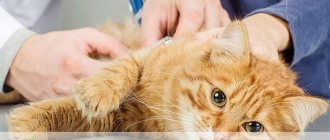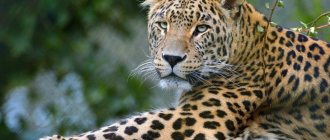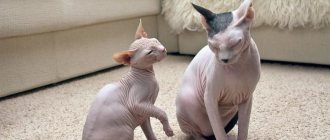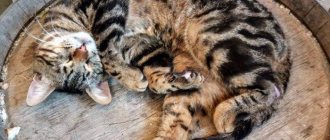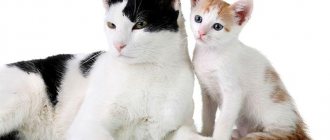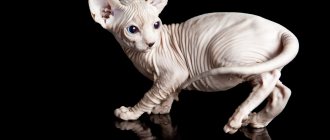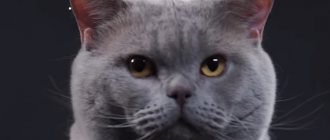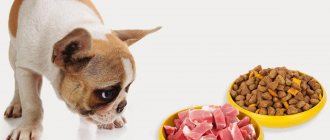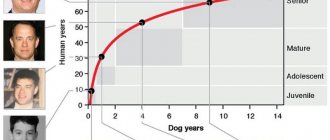The Internet is replete with pictures of people holding at outstretched arms giant cats of the Maine Coon breed - big guys that appeared more than a century and a half ago in the States. Particularly impressive are the pictures where animals are captured with children or miniature girls. This is not surprising, since these cats, firstly, have a long body, secondly, strong bones, and thirdly, luxurious fluffy fur. And the Maine Coon’s weight is also respectable when you compare this breed with other felines. There is information on the Internet that these powerful beauties can weigh more than two dozen kilos, which is actually not true. How much does a Maine Coon weigh in reality? Let's try to find the answer in this article.
The biggest and fattest pet
Cat Katie
The first place among the fattest pets is taken by the cat Katie from Russia. At 5 years old she weighs 23 kilograms. The cat has a girth of 70 centimeters.
One can only envy her diet: two fish in the morning, a piece of meat in the evening, food, milk, grass in the afternoon. Katie can eat two sausages in a minute. The cat became so big because of its owner: she was tired of cat parties and overdosed the medicine.
She doesn’t want to limit the cat’s food because she feels sorry for her. Apparently, it’s not a great pity – such weight won’t lead to anything good.
Himmy the Cat
A large wool bag from Australia weighed 21.3 kilograms. His girth was 84 centimeters.
Himmi was very lazy, moved little and ate a lot. At the age of 10 years, the cat could not even move on his own and died from problems with the respiratory system.
After this, the Guinness Book of Records canceled the title of the fattest cat, so that owners would not overfeed their pets.
The weight of the fattest cats in descending order:
- Katie – 23 kg, Russia.
- Himmi – 21.3 kg, Australia.
- Snowball – 20 kg, Scotland. Spice – 20 kg, USA.
- Tulle – 19.5 kg, Denmark.
- Meow – 18 kg, USA.
- Elvis - 17.5 kg, Germany.
- Otto – 16 kg, USA. Bond – 16 kg, Finland.
- SpongeBob – 15.5 kg, USA.
- Lobster – 14 kg, Australia.
For what reasons does a cat baby not gain weight?
Maine Coons usually grow well and quickly, and by the age of 2 months their weight can reach 1.5 kg. But it also happens that the Maine Coon does not gain weight, which is not the norm. Reasons thought to contribute to poor weight and height gain include:
- Poor food for mother cat.
Lactating female Maine Coons are fed at least 3 times a day with special food for lactating cats or food prepared by a caring owner (lean meat, fresh dairy products, cereals, occasionally fish and boiled eggs, vegetables and vitamins prescribed by a specialist); - If the cat is still too small, he may simply weakly suck his mother's milk.
Or the cat’s milk itself is not enough. To keep babies fed, some owners feed them with cat milk substitutes; - Harmful (toxic) mother's milk.
Milk can be dangerous if the animal suffers from mastitis, metritis, or uterine abscess - problems that are common after childbirth. The milk of an animal that is treated with any medications without the consent of a veterinarian is not at all beneficial; - Lack of vitamins and anemia.
If there are few useful components in mother's milk, Maine Coon babies can easily grow poorly and slowly, and be weak; - Worms.
These parasites are often transmitted to kittens from the mother through milk. Naturally, worms do not leave a chance for weight gain; - Genetic deviation.
It happens that among five kittens one weighs very little and looks too weak. This happens with people too, when one of the twins is in full health, and the other is on the verge; - Disease.
In fact, any disease that was transmitted to the baby from a cat or developed independently can affect weight gain. When the kitten is clearly not feeling well (stool problems, vomiting, temperature (normally it should be 38.5-39.5 degrees), discharge from the nose and eyes, plaintive meowing, etc.), you should quickly run to the veterinarian or call a doctor on house; - Crossing a Maine Coon female with an outbred male.
Usually such cases are excluded, but sometimes they still occur. A half-breed cat may well gain weight more slowly than its purebred counterpart.
The Internet is full of advice on what drug can be administered to a small Maine Coon. Trusting recommendations from cat forums is not always wise. Many medications can do more harm than good. In addition, without a correct diagnosis, treatment cannot begin.
Longest Maine Coon
Stewie
Stewie the cat from America is considered the longest cat.
Its size was 123.19 centimeters from the last hair of the tail to the nose. He was sick with cancer, soon after a course of chemotherapy he began to deteriorate sharply, and the cat died at the age of 8 years.
The owner called him the kindest and most affectionate cat, whose love was enough for everyone. This character is usually found in all Maine Coons.
Lobster
Maine Coon Omar, four years old, from the UK is currently considered the longest cat . From nose to tail, his length is 120 cm.
Omar prefers to eat raw kangaroo meat.
The cat does not like too much attention : when journalists and a large number of people began to take an interest in him, he became lethargic and sad. The photo shows the cat Omar and his owner.
List of the longest cats in descending order:
- Stewie – 123.19 cm, USA.
- Leo – 121.9 cm, USA.
- Lobster - 120 cm, Australia. Bond (Pikkis) – 120 cm, Finland.
- Ludo - 118.33 cm, UK.
Places 10 to 6
This rating is quite arbitrary, since the largest domestic cats do not always differ so significantly in size from their other brothers, who did not find a place in the top. This is especially true for females, who by nature are always smaller than males.
10. Kurilian Bobtail. The hit parade of big cats opens with a large, handsome Kurilian Bobtail. The weight of an adult male ranges around 6.8 kg, females - from 3.5 to 5 kg. This breed was bred on the Kuril Islands and transported to the mainland at the end of the 20th century. A characteristic feature of bobtails is their short tail. These graceful big cats can even compete with dogs in terms of affection for their owner and intelligence. Kurilian Bobtails are usually friendly and love attention.
Kurilian Bobtail
9. Chartreuse. Chartreuse is a large cat whose breed is recognized throughout the world, except Britain. They began to be bred in the French city of Chartres, where the name of these large cats comes from. In the Middle Ages they were called cat-dogs - these animals were so muscular, strong and smart. Males weigh 6-7 kg, females - 5-6. Despite their attachment to their owner, Chartreux are not very talkative and often only purr.
Chartreux are large cats, the breed of which is recognized throughout the world, except Britain.
8. Pixie bob. A domestic cat that is almost identical in appearance to the bobcat is the pixie bob. The breed was artificially bred in the USA and is translated as “short-tailed elf.” You should not take the external severity and severity of these cats seriously: pixie-bobs love tenderness, are very tactful and unobtrusive. They do not reach the size of a lynx, but belong to the list of large cats weighing from 5 to 7.7 kg.
Pixie bob. A domestic cat that is almost identical in appearance to the lynx is the pixie bob.
7. Norwegian forest. The hardiest cat in the world, adapted to harsh conditions, is the Norwegian Forest Beauty. This magnificent cat breed has very thick and long hair, fur folds on the neck, and a fluffy tail. The weight of an adult cat can reach 9 kg. Despite their size, these cats are agile, strong and fast. These are animals with innate hunting instincts who love freedom. But they also treat people quite friendly.
Norwegian forest. The most resilient cat in the world, adapted to harsh conditions
6. Turkish van. Giant Van cats get their name from the area of the Turkish salt lake Van. Today, this breed of large cats is the rarest and is distributed mainly in Turkey. A typical Van has a truly cat-like disposition, is freedom-loving and independent, energetic and loves space. And also - swim. Perhaps this is due to the inextricable connection between his homeland and water.
Giant Van cats got their name from the area of the Turkish salt lake Van.
The tallest Savannah cat
Arcturus
His height is 48.4 centimeters. He is young enough, there is a possibility that he will become even taller after some time .
Arcturus consumes 1 kilogram of food per day. From his fame, the owners earned a lot of money, which they used to develop their animal shelter.
Recently, he and his neighbor Cygnus (the cat with the longest tail) disappeared after a house fire. The owners hope that the pets are alive and will be found soon.
Trouble
Trouble, who lived in America, reached a height of 48.26 centimeters and was considered the tallest cat for a very long time.
He is a cross between a domestic cat and a wild African serval. Cats of this breed can grow up to 60 cm in height and weigh up to 15 kg. But Trouble is not that heavy: he weighed only 9 kilograms.
He doesn't like cat food and only eats lightly cooked raw rabbit and beef. The cat was very active and loved various games. Died in 2012. The photo shows a skinny Trouble.
How to determine a cat's normal weight
You can assess the condition of your pet visually by looking at the animal from different angles. Thus, assessing the condition when looking in profile will allow you to assess the condition of the abdomen and limbs, and looking from above will help you determine the waist and evaluate the lumbar region.
For a more accurate assessment, it would be a good idea to palpate your pet’s body. Walk your hands along the ribs without pressing too hard. If the bones stick out with a slight touch, then - exhaustion, but if you need to make an effort and apply pressure to palpate - obesity.
Then you can move on to the waist. This area is sensitive, so you should handle your pet carefully. By running your palms along the waist to the pelvis, you can feel the almost hourglass shape. In obese cats, the waist cannot be felt.
You should pay attention to the stomach. A little softness on your stomach is completely normal. But if the abdominal fold hangs down and sways in different directions when the cat moves, then this is a sign of obesity.
But if the abdominal fold hangs down and sways in different directions when the cat moves, then this is a sign of obesity.
Flaw
Very thin hairless and short-haired individuals with low weight have visible ribs, very pronounced pelvic bones and a spine with minimal muscle mass, with a minimal layer of fat or no fat at all. The ribs can be easily felt. The stomach is strongly tucked. The neck is thin. In such a situation, the help of a veterinarian is necessary; perhaps the animal has health problems, for example, a helminthic infestation.
In thin individuals, the ribs are easily noticeable, muscle mass and a layer of fat are minimal. The vertebrae are clearly visible, the waist is visible. The abdominal fold is weakly defined with minimal fat.
Ideal
At ideal weight, cats have a well-proportioned body with a noticeable waist after the ribs. The waist is clearly visible when viewed from above (the shape of the torso resembles an hourglass shape). The ribs can be felt, but the fat layer is minimal. When viewed from the side, the stomach is tucked in. But breed characteristics should be taken into account. After all, representatives of some breeds are built more elegantly and refinedly, while others are naturally stocky and heavy; in such animals the presence of an abdominal fold can be considered normal in accordance with the Standard.
Excess
In slightly overweight pets, ribs covered with a small amount of fat may be palpable. The waist is little noticeable. At a more advanced stage of obesity, the waist is indistinguishable, the ribs are hidden under a layer of fat and cannot be felt, the stomach is rounded, and there is a clear presence of fatty tissue in the abdominal area. Fat deposits are present on the face and on the limbs, lower back, and even on the tail. If you are obese, you need the help of a veterinarian who will give recommendations on proper nutrition and exercise regimen that will help you lose weight. With self-control, you should act gradually; you should not allow sudden weight loss. Changes are made to the diet, namely reducing the caloric content of food or selecting appropriate dry food for cats suffering from or predisposed to obesity.
Excess weight can lead to a number of health problems, so it is important to control your pet’s diet and prevent overeating. Of course, you can pamper your pet, but within reason, because what could be more important than the health of a cat, whose life expectancy is already short. Returning to the problem of obesity, it is worth mentioning the possible problems it leads to: diabetes mellitus, heart disease, liver dysfunction, joint diseases
Returning to the problem of obesity, we should mention the possible problems it leads to: diabetes, heart disease, liver dysfunction, joint diseases.
Giant liger Hercules
The cat named Hercules is a cross between a male lion and a female tiger. He is not a domestic cat, but lives with a person and loves his owner very much.
How much does this huge cat weigh? The body weight of this liger is 408.23 kilograms! This is normal for Hercules; he is not obese. He eats 9 kilograms of meat a day.
He could eat about 40 kilograms, but then the weight could reach 700 kilograms. Hercules would not be able to move due to obesity.
This is a very large, agile and active cat. He loves to run and is an excellent swimmer. From the nose to the end of the tail, the length of the liger is 3 meters 70 centimeters. Its height is 1.86 meters. The maximum speed of this cat is 80 km/h.
Hercules has tiger stripes on his body, but a lion's face. His mane has not grown. For many years it has been considered the largest representative of the cat family . There are only 25 ligers in the world. The photo shows Hercules with his owner.
The liger named Sudan is taller than Hercules and is 4 meters long.
Weight deviation from the expected weight and its impact on health
You need to know about the negative health consequences of both overweight and underweight pets. Excess weight above normal can cause various diseases (diabetes, cardiovascular and gastrointestinal diseases, arthritis) and reduce life expectancy. Obesity is especially dangerous for young cats. Insufficient weight appears due to poor feeding of the cat or due to the presence of certain diseases (metabolic disorders, diseases of the gastrointestinal tract, cancer) and can lead to the development of hypovitaminosis and exhaustion.
shutterstock

